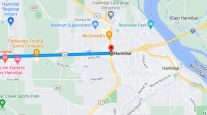Staff Reporter
DOT Unveils Applicant Toolkit for Rural Communities

[Stay on top of transportation news: Get TTNews in your inbox.]
The U.S. Department of Transportation created a toolkit intended to help those interested in participating in the Rural Opportunities to Use Transportation for Economic Success program.
Known as ROUTES, the program was created in October 2019, and it is meant to help connectivity in rural communities. Transportation Secretary Elaine Chao on July 27 unveiled the toolkit, which provides information and resources. Its purpose is to help rural applicants understand and navigate DOT’s discretionary grant funding opportunities.
Specifically, the toolkit outlines applicant requirements and sorts grant programs by applicant type and eligible project activities. The toolkit was designed for applicants with varying levels of experience.
“This toolkit will help both the beginner and the experienced better understand, identify and navigate discretionary grant funding opportunities for rural transportation projects,” Chao said during a video announcement. “There are a lot of rural communities who just don’t have the resources to hire an army of dedicated staff and contractors to compete for these federal funds.
“We hope that this toolkit will be a reference and a road map to opportunities and resources at the U.S. Department of Transportation that will benefit your community and our country.”
Rural roads make up 70% of America’s road miles, according to DOT. Maintaining these roadways can be a challenge for rural communities that have thin financial resources. Although geographically sprawling, rural communities generally have low population densities, meaning fewer people to support investment.
Chao noted that infrastructure upgrades can improve safety, which also can be a challenge in rural areas. She said that although 19% of the population lives in rural areas, 45% of highway fatalities occur in rural areas.
In terms of economic activity, Chao said rural communities play an important role. According to Chao, two-thirds of freight moving by rail comes from rural areas, and nearly half the distance traveled by trucks takes place on rural roads.
“Rural transportation is important to our economy and our way of life,” Chao said. “Manufactured goods, raw materials and agricultural products travel through rural areas on their way to global markets.”
.@SecElaineChao today announced the Applicant Toolkit for the Rural Opportunities to Use Transportation for Economic Success (ROUTES) Initiative, the latest effort by the Department & the Trump Administration to improve rural access to federal grant funds. https://t.co/1bOuWtHqrJ — TransportationGov (@USDOT) July 27, 2020
The ROUTES initiative’s steering council includes representatives from the Federal Highway Administration, the Federal Transit Administration, the Federal Railroad Administration and the Federal Aviation Administration.
DOT has placed an emphasis on rural community needs through some of its popular grant programs. For example, the Infrastructure For Rebuilding America grant program directs a certain amount of funds toward rural projects. In the latest round of INFRA grants, announced June 18, 53% of the funding was devoted to projects in rural areas.
In the latest round of Better Utilizing Investments to Leverage Development (BUILD) discretionary grants, issued in November 2019, half of the $900 million in funding was awarded to projects in rural areas.
Want more news? Listen to today's daily briefing:
Subscribe: Apple Podcasts | Spotify | Amazon Alexa | Google Assistant | More




